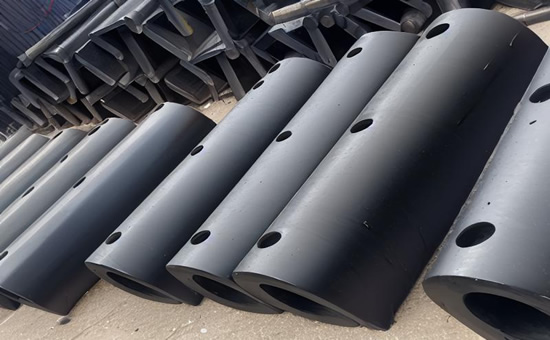Dock ship rubber fenders are a device used to reduce the collision energy among ships and docks, and they play an important role in protecting ships and terminals from damage. Natural rubber has good elasticity and abrasion resistance, and is one of the ideal raw materials for the manufacture of rubber fenders. However, the price of natural rubber is high and the price fluctuates greatly, so fender manufacturers expect to add some low-cost rubber raw materials to reduce costs; The tread reclaimed rubber processed from the tread of waste tires has high strength, good elasticity, wear resistance and tear resistance, and can be used as a substitute raw material for natural rubber to produce rubber fenders and reduce the cost of raw materials.
The rubber fenders of wharf ships are mostly made of natural rubber, which has good mechanical properties, fatigue resistance, shear resistance, good elasticity and low temperature resistance. However, natural rubber has poor aging resistance, which can generally be improved by adjusting the protection system and using it in combination with other rubber. Compared with natural rubber, tread reclaimed rubber has good plasticity, uniform dispersion of compounding agent, and less power required for rubber mixing; Combined with natural rubber, it can also play a role in lubrication; It is a vulcanized rubber product, with small expansion and contraction; Low vulcanization reversion; The combination with natural rubber can also improve the aging resistance of the rubber compound.
Therefore, natural rubber can be used together with tread reclaimed rubber to produce wharf ship rubber fenders, which can not only reduce the cost of raw materials, but also improve the processing performance, reduce production energy consumption, and improve the aging resistance of finished products.

Vulcanization formula of natural rubber production terminal ship rubber fenders: 100 parts of natural rubber, 16 parts of zinc oxide, 3 parts of stearic acid, 1.5 parts of antioxidant D/4010, 1 part of white wax, 4 parts of pine tar, 40 parts of high wear-resistant carbon black, 1 part of accelerator CZ, 2.9 parts of sulfur; Total 169.4 copies. Natural rubber/tread reclaimed rubber combined with the production of wharf ship rubber fender vulcanization formula: 100 parts of natural rubber, 150 parts of tread reclaimed rubber, 8 parts of stearic acid, 1 part of antioxidant 4010, 1.5 parts of antioxidant RD, 40 parts of engine oil, 30 parts of petroleum jelly, 30 parts of black ointment, 15 parts of carbon black N774, 30 parts of light calcium, 1.5 parts of accelerator DM, 1 part of accelerator M, 2.5 parts of accelerator TMTD, 2.5 parts of sulfur, 7 parts of foaming agent H, 15 parts of baking soda, 10 parts of alum; Total 445 copies.
Dock ship rubber fenders can be divided into two categories: solid rubber fenders (non-floating type) and floating rubber fenders. Solid rubber fenders have the advantages of high energy absorption and reaction force, and at the same time have the advantages of low cost, long service life, and simple installation and maintenance. The floating rubber fender has the characteristics of large compression deformation, large energy absorption, small reaction force, self-floating, easy installation, etc., and is suitable for installation at the wharf with large tide level changes.
When using tread reclaimed rubber to produce ship rubber fenders, select appropriate reclaimed rubber products according to the performance requirements of different rubber fenders, and reasonably determine the proportion of tread reclaimed rubber; We will continue to discuss these issues with you in the future.
Exclusive original article [commercial authorization] reprint, excerpt and excerpt in any form are prohibited without written authorization. Focus on Hongyun rubber: learn the process formula and raw material technology of producing rubber products from recycled rubber to help you reduce costs and increase profits